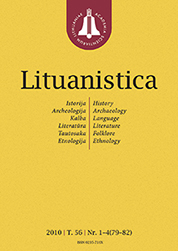LituanisticaWHAT?
 ISSN 0235-716X |
2005 m. Nr. 3 Mirties etika Lietuvos kaimo kultūroje
Based on historical, ethnographic and folklore sources, the author analyses how the inhabitants of Lithuanian villages and small towns perceived the needs of the deceased and their own duties, harmonized the differences in the world outlook, and what were the changes in this traditional relation between the alive and the dead in the 20th and early in the 21th centuries.
Up to the very 20th c., in Lithuania survived the controversy between the pre-Christian and Christian perception of death. On the interface between these two attitudes, contaminations of the normative faiths developed as a basis for the ethical treatment of the deceased, acceptable to the society, family and individual (Scheme 1): Pre-Christian death was perceived as the same quality life continuation. It induced the ethic norms that stimulated a constant internal relation within an imaginary local community of the alive and the dead as an interrelation between the physical and transcendental existence, which ensured the safety of the alive and the preserved merit and earthly status in heaven of the deceased. Up to the 20th century survived the importance of defending the motherland and its freedom as the highest ethical imperative. The remains of the pre-Christian faith of the Balts became spontaneously integrated into Christian culture. The symbolics of death in Lithuania was related to prehistorical interment which later, in christened Lithuania, was revived. This symbolics was expressed by the relics of the deceased with the shroud – a scythe and a sheet. The name of death was a taboo. It was replaced by numerous phraseologisms, which serve to hide the fear characteristic of ritual joking. Under the influence of Christianity, mass ritual suicides, ritual marriage to the deceased lost their sense. The Christian world outlook separated the alive from the dead, the latter being granted by God a space and posthumous status not according to one’s wealth but depending on his or her spiritual merits. The eulogy of the deceased and mournful screams, common in pre-Christian ethics, under the influence of Christianity and of funeral poetry popular in the 16th c. in the course of time turned into a unified genre of lament, which in the 20th c. almost in all Lithuania lost its ethical value and was replaced by solemn funeral speeches at the grave. The personal (Fig. 3) and communal (Figs. 1, 2) bidding farewell to the deceased and a specific seeingoff ceremony of unmarried people have survived (Fig. 1). The individual’s personal ethic and aesthetic views and the ideological factors that influenced him or her not always coincided with the model of views of a local community. In Lithuanian country, even in poor believers’ families, ethics required to observe the ethnic and local Christian traditions clad in the garb of transient fashion while taking care of the dying or the deceased. |
Numeriai:
2011 - T.57 Nr.1, Nr.2, Nr.3, Nr.4 2010 - T.56 Nr.1-4 2009 - T.55 Nr.1-2, Nr.3-4 2008 - T.54 Nr.1, Nr.2, Nr.3, Nr.4 2007 - T.53 Nr.1, Nr.2, Nr.3, Nr.4 2006 Nr.1, Nr.2, Nr.3, Nr.4 2005 Nr.1, Nr.2, Nr.3, Nr.4 2004 Nr.1, Nr.2, Nr.3, Nr.4 2003 Nr.1, Nr.2, Nr.3, Nr.4 2002 Nr.1, Nr.2, Nr.3, Nr.4 2001 Nr.1, Nr.2, Nr.3, Nr.4 |